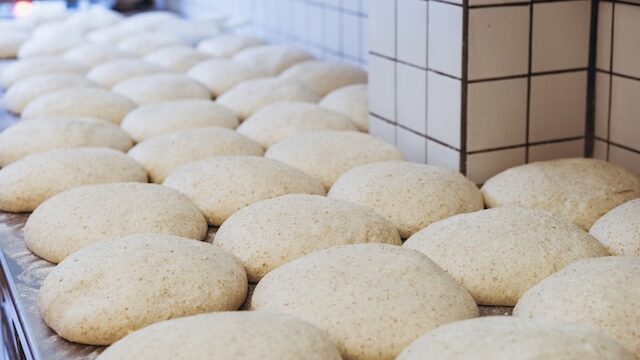Many different devices can be used to blend solids. Selection can be based on flow properties or more complex measures like particle size distribution. However, it is still common for solids to segregate on discharge from the blender or for the resulting powder to have unacceptable characteristics.
How a Ribbon Blender Works
A ribbon blender consists of a U-shaped horizontal trough with a double helical ribbon agitator that rotates within. The agitator’s inner and outer ribbon spirals are pitched to move material axially in opposite directions and radially, allowing the blender to mix well. Ribbons run at peripheral speeds of up to 300 feet per minute (tip speed). The axial and radial movement combination provides efficient, thorough blending in a short mixing cycle — usually 15 to 20 minutes. Optimal blending is achieved with uniform particle size and bulk-density ingredients. Ribbon blender drive options vary, but modern gear motors are more energy-efficient and compact than belt-driven models. They eliminate issues like belt stretches and excessive overhung loads on the reducer shaft bearings that limit equipment service life. Other customizations include air-purged shaft seals and load cell systems for precise blending. They can also be built with various materials for demanding applications, including Hastelloy C-276 and abrasion-resistant carbon steel.
Choosing a Ribbon Blender
Ribbon Blenders are quick and easy to use. They offer high-speed blending, are extremely user-friendly and can be easily customized to fit your unique production needs. They are also highly versatile and can be used for various applications. To choose the right Ribbon Blender for your application, consider your desired batch volume and bulk density. Bulk density will help you determine the proper blender size, motor horsepower and whether a standard or heavy-duty model is needed. Another factor to consider is how your ingredients exit the mixer. For example, if your products are fragile, consider a paddle agitator instead of a ribbon agitator to avoid pinch points that compress and damage delicate products. A drop-bottom discharge gate also ensures thorough discharge and helps prevent cross-contamination between batches. Finally, look for a Ribbon Blender with PLC recipe controls that enhance batch-to-batch consistency and enable data logging.
Getting Started with a Ribbon Blender
Before selecting a ribbon blender for your operation, carefully determine the bulk density of your product. Unlike batch weight, this determines the blender’s capacity and helps to decide whether a standard or heavy-duty model is required. The mixing agitator of your choice is also a crucial consideration. Ribbon, paddle and plow agitators offer specific benefits in different application types. A sanitary design that includes a drop-bottom discharge valve also helps to protect against cross-contamination between batches. This feature is particularly important in hygienic applications such as food processing, pharmaceuticals and cosmetic powders. A gear motor typically drives modern ribbon blenders. These single-piece motor reducers work well with electronic inverters, allowing speed control, soft starts and overload protection. This eliminates the issues of belt slippage and stretching that plague traditional belt-driven blender designs. It also ensures less maintenance and greater operating efficiency.
Maintenance
The sheer number of ingredients in each product that ends up on a consumer’s shelf or medicine cabinet is a constant challenge for manufacturers. Ribbon blenders play a crucial role in mixing dry solids or powder components to create the items we use daily. Tight tolerances between the ribbon blade and the U-shaped trough eliminate dead zones where particles can stagnate or build up. Removing the ribbon agitator allows easier cleaning, reducing downtime between batches. Optional PLC recipe controls enhance batch-to-batch consistency and enable data logging for improved quality control. Ribbon Blenders can be equipped with various drive mechanisms, including a gearmotor, which reduces maintenance by eliminating the need to align and adjust belts or couplings periodically. Depending on the size and shape of the blender tank, an impingement or rotary jet head cleaning device is recommended to help you reach shadow areas within the trough. These CIP devices can significantly speed up your sanitary process and reduce the time required to fill, drain, and manually clean the blender.
